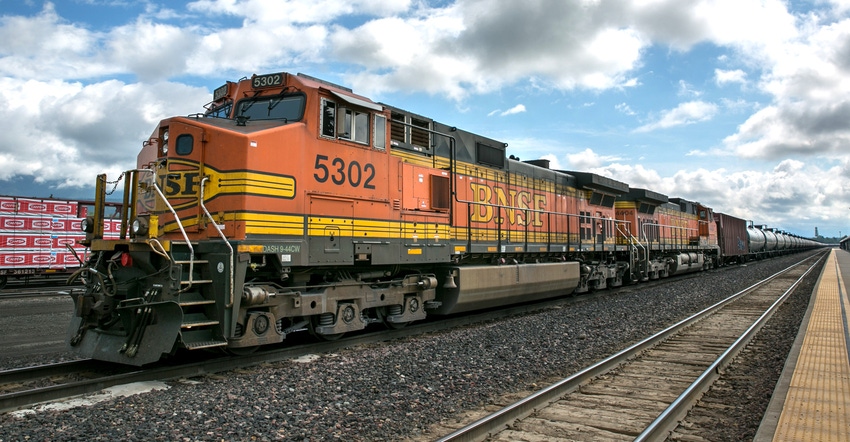April 8, 2021

In the U.S., our preferred mode of transportation is parked in our own driveways and garages. We want to go when we want where we want, so we have invested in trucks, cars and motorcycles.
When we talk about investing in transportation infrastructure, sometimes we only think about roads and bridges, and that pothole that nearly blew our tire.
Looking at the bigger picture for agriculture, we know how important other modes affect movement of product from farm to buyer— global shipping, trucking and rail.
The latter — the railroad — was the topic during a recent Minnesota Farmers Union virtual meeting. John Apitz, executive director with the Minnesota Regional Railroad Association, was joined by Lydia Bjorge, director of public affairs for BNSF, and Maia LaSalle, BNSF’s manager of ag operations, for a primer on the railroad’s impact in Minnesota. Here is what we learned.
Minnesota is a rail-rich state. Apitz said we have nearly 4,500 route miles, ranking Minnesota eighth in the U.S. for rails. We have four Class 1 freight rails operating: BNSF, Canadian Pacific, Union Pacific and Canadian National, and they carry ag products to ports in Duluth, New Orleans and the Pacific Northwest. We have 14 short-line and regional railroads — Twin Cities & Western, Red River Valley & Western and Progressive — that connect with the larger railroads, hauling grain, food, fertilizer, ethanol, metallic ores and other commodities.
The first train in Minnesota operated for 5 miles between St. Paul and St. Anthony (later named Minneapolis) in 1862.
Rail freight is increasing. In Minnesota, trucking moves 63% of our freight, followed by rail at 25%. Freight by rail has been increasing, too, with 300 million tons moved annually. Projections into 2040 estimate a 200% increase in freight. One railcar can move the equivalent volume of 3.5 truck trailers, uses 75% less fuel and has lower emissions. One gallon of fuel moves 1 ton of freight 435 miles.
Railroads are getting safer. Rail accidents have dropped by 45% since 2000 and 80% since 1980, along with employee injuries and grade-crossing collisions. Technology improvements have gone a long way to improve safety. Those include self-powered roaming 24/7 rail cars that ride along to check track for dips or other defects, and using drones to check track condition.
Exports from Minnesota are growing. BNSF ships enough grain to supply 900 million people with a year’s supply of bread. It ships enough coal to power 1 out of every 16 homes. One in 10 automobiles in the U.S. has been on a BNSF train, Bjorge said. However, oil and coal freight have been declining.
LaSalle noted that agriculture was the bright spot in 2020 for BNSF, with a 4% increase in freight, while overall volume decreased 7%. Coal was down 22%, industrial product dropped 16% and consumer products dipped 1.4%.
Over the last 18 years, BNSF’s growth has been driven by agriculture’s success, she noted.
“2020 was the second-highest year for grain,” she said. “Ag production was the second-highest year in volume.” She added that she sees ethanol demand increasing as inventory is rebuilt. And that February’s brutal subzero temps severely impacted rail.
“We had -63 windchills in February. Trains don’t move when it’s that cold,” she said. BNSF is still recovering from the winter blast, as well as the impacts from the Texas blackouts.
The Twin Cities is a prime spot. The growth in railroad shuttles is due to farm demand. The Twin Cities is a major hub for the rail shuttle network, Apitz said. The Twin Cities originates more than one-third of the country’s ag product volume.
During a question-and-answer session, a few farmers asked about blocked railroad crossings with parked trains. They voiced concerns about how long trains sit parked, and the inability of emergency vehicles to pass through. They realize some trains are quite long and wondered if they could be split when left to sit. Bjorge said BNSF doesn’t like for that to happen, but it does when there is a crew change or a repair. However, if the blocking is routine, she said to contact her. “That shouldn’t happen for 24 hours,” she added. Apitz noted that during the subzero temps, it was a challenge to move longer trains after they had parked.
I appreciated learning more agriculture’s role in developing the state’s rail system. Kudos to our innovative, productive farmers!
You May Also Like




